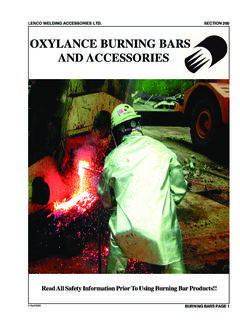Transcription of Lightning-Season Burning: Friend or Foe of Breeding Birds?
1 Lightning-Season burning : Friend or Foe of Breeding Birds? By Jim Cox & Brent WidenerTall Timbers Research Station & Land ConservancyTall Timbers Research Station Miscellaneous Publication 1723 Summary4 Fire: The Force Shaping Southern Forests5 What About Nesting Birds? 6 Birds of Management Concern7 Northern Bobwhite8 Wild Turkey9 Red-cockaded Woodpecker9 Brown-headed Nuthatch10 Loggerhead Shrike10 Bachman s Sparrow11 Henslow s Sparrow12 Impacts to Other Breeding Birds13 Conclusions13 Recommendations14 Literature CitationsContentsThe Power of Flight Program created by the Southern Company and the National Fish and Wildlife Foundation protects birds through habitat and species restoration and environmental education. The program focuses on southern birds, such as Bobwhite Quail, the endangered Red-cockaded Woodpecker, American Swallow-tailed Kite, and Bachman s Sparrow.
2 The program has improved quail habitat on more than 37,000 acres across the region as well as habitat for endangered Mississippi Sandhill Cranes, beach-nesting shorebirds, waterfowl, and wading birds. Southern Company has committed $ million in matching funds to the program over 10 years in support of projects that benefit southern birds and their MastersBachman's SparrowNorthern BobwhiteLoggerhead ShrikeWild TurkeyShane WellendorfRoss McGregorUSFWSUSFWSS uggested citation: Cox, J. and B. Widener. 2008. Lightning-Season burning : Friend or foe of Breeding birds? Miscellaneous Publication 17, Tall Timbers Research Station, Tallahassee, FL. decades, the prescribed fires needed to maintain suitable habitat conditions for pineland birds were applied early in the calendar year ( , before April) when cooler temperatures and steady winds prevailed.
3 More recently, some land managers have shifted to burning areas dominated by native forbs and grasses later in the year ( , after April) both to increase the acreage treated with fire each year and also in consideration of ecological observations. The shift to burning later in the year has led to concerns about the effects such burns may have on nesting birds. We reviewed recent research on the effects of Lightning-Season burning on the Breeding birds associated with southern pine forests. The threat posed to nesting birds generally is not as severe as perceived, though additional research is needed for several species. Many ground-nesting birds that might be affected by burns prefer to nest in areas that have been burned recently ( , within the past 18-24 months), so the number of nests located in areas typically scheduled for lighting-season burns will be small relative to the total number of nests constructed each year.
4 Birds also frequently re-nest following the loss of a nest, and improved habitat conditions created through the application of prescribed fire may improve adult and juvenile sur-vival and effectively offset the loss of a nest. Burns set in May also provide time for nests of some species to fledge but also are early enough to avoid peak nesting activity for Northern Bobwhite. Late-season burning does not pose a threat to nesting birds when it is included as part of a comprehensive burn program and is used to achieve the fire frequencies required to maintain suitable habitat conditions for many pineland birds on large managed areas. For several pineland species that are experiencing steep population declines, the preferred fire frequency is burning every two-to-three can be more destructive to ground nesting game birds than summer Stoddard 1931(Summer fires).
5 Are key in restoring and maintaining the herbaceous vegetation so crucial to brood-rearing for species like bobwhite quail and wild turkey. South Carolina Department of Natural Resources 2006 Rose Rodriguez4 Figure 1. Southern pine forests that have been burned frequently using a one-to-three year fire interval have a majestic park-like look. This picture shows the Wade Tract, a longleaf pine research area in southwest Georgia. Figure 2. A prescribed fire clearing ground vegetation. Prescribed fire is as important as sunlight, air, and rain for southern pine forests. The slow-moving fires used to man-age southern pine forests clear brush, recycle nutrients, and create open conditions where native forbs and grasses flourish. Prescribed fires allow grassland and forest elements to merge in a beautiful park-like setting (Fig.)
6 1) and create conditions where species like Northern Bobwhite, Bachman s Sparrow, and Red-cockaded Woodpecker decades, prescribed fires (Fig. 2) needed to main-tain open pinewoods were applied early in the calendar year when cooler temperatures and steady winds prevailed. More recently, some land managers have shifted to burning later in the year sometimes as late as August -- because research suggests this may have been the time of year when Mother Nature liked to burn. Some evidence supporting this approach lies in the prolific flowering responses that dominant plants exhibit when fires are conducted after late April in areas with natives forbs and grasses (Fig. 3). Additional evidence comes from the burn scars found on ancient pine stumps (Huffman 2006). These scars recorded fire events prior to extensive European settlement and suggested the fires burning from 1670-1830 occurred later in the calendar year.
7 Finally, wildfires ignited by lightning in Florida from 1995-2001 (Freeman 2004) took place nearly exclusively from May to August, not February to practical considerations also have led some manag-ers to look carefully at Lightning-Season burning (definitions provided to right). First, Lightning-Season fires can be more ef-fective in restoring grass and forb ground cover in areas where hardwood shrubs and saw palmetto have become a nuisance (Glitzenstein et al. 1995). Second, Lightning-Season burns create good conditions for natural pine seedling establishment in fall and winter (Hermann et al. 1998; Fig. 4). Seed produc-tion for longleaf pine in particular is variable from year to year, and years with good seed crops can be difficult to discern very early in the calendar year. Lightning-Season fires also pro-vide the open ground-cover conditions that improve longleaf germination and establishment.
8 Finally and perhaps most important, Lightning-Season fires provide a broader window within which burns can be conducted, and this could lead to a much-needed increase in the acreage burned each : The Force Shaping Southern ForestsRon MastersJim Cox5 Figure 4. Established longleaf pine seedlings. Figure 3. Wiregrass with flower stalks emerging. Figure 5. Bachman s sparrow nest. Season of Fire TerminologyThe terms used to describe the season of burning can be confusing. Phrases such as warm and cool season, summer and winter, growing and dormant season, and lightning and non- lightning season are used, but dates defined by these phrases depend on latitude and local conditions. The phrase Lightning-Season burning describes the underlying rationale for burning later in the calendar year because it focuses on natural ignition that can take place when lower humidity and higher thunderstorm activity coincide.
9 In north Florida, for example, the requisite combination of increased thunderstorm activity and low humidity is common in late spring and early summer (Komarek 1964). Further north, appropriate conditions occur at different times and may be bimodal. Because the Lightning-Season is defined by local weather, appropriate times may stretch from late April to About Nesting Birds? Interest in Lightning-Season burning has not come with-out controversy (Hermann et al. 1998, Sisson and Speake 1994, Tucker et al. 2004). Prescribed fires set anytime after late February coincide with the nesting season of one or more pineland Breeding birds, and bird nests built of dried grasses and twigs (Fig. 5) and placed in shrubs or directly on the ground obviously are no match for fire. At first glance, Lightning-Season fires appear capable of destroying scores of nests, and concerns about the effect that fires set during the Breeding season may have on Breeding birds have surfaced on several fronts (Tucker et al.)
10 2004, Tyler 2006). The situation for Breeding birds is much more complex than Lightning-Season burning being bad or good. In any given year, many nests are lost to snakes, ants, raccoons, heavy rains, drought, cats, opossums, deer, coyotes, dogs, foxes, mice, and heavy equipment -- not fires. Lightning-Season burns destroy some nests and obviously have a direct effect on nesting activity, but, unlike the other threats that nesting birds face, Lightning-Season fires provide clear benefits that have the potential to offset losses in a big way. For example, if Lightning-Season burns provide a 5% increase in the survival of adults and juveniles as a result of habitat improvements, these increases could offset a 15% reduction in nest produc-tivity attributable to recent studies have concluded that the threat posed by Lightning-Season burning is not as dire as once presumed (Cox and Jones 2007, Tucker et al.






